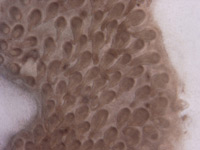
Feather Bud Development


Procedure:
1. Obtain a six-well plate. In each well, pipette 1.8 ml of
Hank’s Balanced Salt Solution 1X. Rest Transwell 3452
culture inserts (24mm diameter) over the wells containing
the salt solution.
2. Wash eight eight-day-old chick eggs with 70% ethanol.
Open the chick embryos as demonstrated in class (at the
blunt end of the shell, where the air sac is located), using
forceps. Record the stages of the embryos, making sure to
keep tract of which embryo is at which stage as they are
removed from their shells.
3. Empty the embryos into separate petri dishes and remove
them from their yolks. Then place the isolated chick
embryos, using a plastic spoon, into smaller petri dishes
(60mm) containing Howard
Ringers Solution.
4. Cut away the anterior portion (i.e. remove the head) of
the embryo using either scissors or forceps. Make a shallow
incision along the trunk of the embryo and peel off as large
a por-tion of skin as possible. Place this skin segment onto
an insert covering one of the wells filled with Hank’s
solution. Make sure the ≤inside "portion of the skin
is touching the disk (see DB Lab CD;
Cebra-Thomas, 2001).
5. Place well plates with skin cultures into an incubator,
set at 5% CO2 and 37æC. Observe development of skin
cultures periodically over a weeks time, noting the
appearance and development of feather buds. Record
observations and photograph skin cultures at every
observation point to determine the extent to which the skin
develops.
6. Limbs from the embryos may also be placed in analogous
culture conditions (same media) with the caveat of using
non-collagen culture inserts so that the limbs won’t
stick too closely to the insert. These too may be observed
periodically to determine if there would be any further
development of the limbs, or feather buds on the limbs.
Download prepsheet PDF